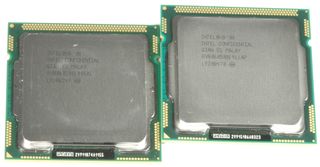Does Turbo Boost Help Or Hurt Core i5/i7's Power Efficiency?

LGA 1156 Core i5/i7 Efficiency Explored
Intel’s new LGA 1156-based processors, namely the Core i5-700- and Core i7-800-series, arrived with a bang. Our launch article by Chris Angelini provides all the key information. But, in short, the new processor delivers increased performance compared to Core 2 Quad. No surprise there. But Intel also claims that power consumption went down significantly, so we decided to tackle this prospect with a closer look.

The Core i5 Innovation
The new P55 platform and Intel’s Lynnfield processors make a are impressive enough from a performance angle, but I’d like to look at the facts from a different perspective. The platform’s foundation still centers on the Nehalem architecture first seen as Core i7 for LGA 1366 late last year, hence the level of innovation in Lynnfield is less revolutionary and more of an evolution.
Intel is great at tweaking, though. From a technology standpoint, Core i5 incorporates a lot more integration, stepping closer to the inevitable SoC (system-on-chip) future by adding PCI Express onto the die. A more aggressive implementation of Turbo Boost adds extra performance for non-threaded applications. Considering that Intel plans to integrate graphics with Clarkdale in coming months, this step could also be looked at as a necessity. Improved Turbo Boost is another building block for turning dynamic overclocking into a real feature. In reality, though, the large motherboard makers have been offering similar features for a few years already.
I see two main benefits of the new LGA 1156 processors for buyers. First, you have decreased power consumption thanks to the integrated memory controller and PCI Express 2.0 interface. The second benefit is performance. Turbo Boost helps to elevate LGA 1156-based parts to Core i7-900-class performance levels in certain applications. Both benefits became obvious in our article, Intel’s Mainstream Magnum Opus.
Performance Increase Where It's Needed
The current generation of Turbo Boost accelerates a single core by four 133 MHz increments (or bins) in the case of Core i5-700-series and by as many as five increments for the Core i7-800-series. This equals clock speed bumps of 533 and 667 MHz. Two cores can accelerate by four clock speed increments, while three and four cores still may receive a simultaneous 133 MHz boost (up to 266 MHz for the top model Core i7-860). Obviously, the new chips operate with higher power consumption every time Turbo Boost kicks in, though they're kept under a 95W ceiling by Intel's on-die Power Control Unit.
Stay on the Cutting Edge
Join the experts who read Tom's Hardware for the inside track on enthusiast PC tech news — and have for over 25 years. We'll send breaking news and in-depth reviews of CPUs, GPUs, AI, maker hardware and more straight to your inbox.
Power Down?
We want to answer some basic questions: What is the real reduction in system power consumption compared to Core 2 Quad platforms? What is the efficiency (performance per watt) for the new LGA 1156 generation? What’s the difference in efficiency for a LGA 1156 system with and without Turbo Boost enabled?
Most Popular

